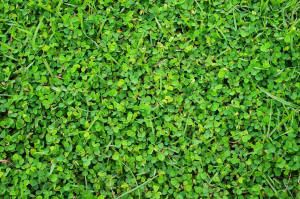|
 Grow
a Bee-Friendly Lawn Grow
a Bee-Friendly Lawn
By Melinda Myers
[August 23, 2025]
Boost the bee
and pollinator appeal of your lawn by incorporating microclover,
self-heal, creeping thyme, crocus, grape hyacinths and other
bee-friendly flowering plants in your lawn. You’ll create and enjoy
a carpet of green with splashes of color and one that requires less
ongoing maintenance. The pollinators will benefit from the
nutritious sources of nectar and pollen your bee lawn provides. |
|
Flowering bee lawns include traditional lawn grasses
combined with other hardy grasses, like fine fescues as well as warm
season centipede grass. Kentucky bluegrass and Bermuda grass also
combine well with bee-friendly plants but require more ongoing care
than fescues and centipede grass. You’ll be creating a more diverse
lawn that not only appeals to bees but also is more resilient to
pests and environmental stressors than traditional lawn grasses.
Consult your local university extension service for help in
selecting the best lawn grasses and bee-friendly plants.
Like any new addition to the landscape or garden, it does require
some effort. But once established, you’ll be spending less time with
ongoing care like watering, mowing and fertilization.
Start by evaluating your current lawn situation. If grass is growing
well in the area, so will a bee lawn. This is not an all or nothing
endeavor and like any new undertaking, starting small is always a
good strategy.
Consider converting just lesser-used spaces. This allows bees and
butterflies to forage in peace. And even though native bees are
docile and typically don’t sting, neither the kids nor bees want to
share the same space.
Keep your neighbors in mind when selecting a space for your bee
lawn. Those neighbors with pristine lawns may be less tolerant of
your bee lawn. Selecting areas surrounded by walks and drives will
also help keep aggressive plants inbounds.
Consider starting your bee lawn by overseeding the white microclover
into your existing lawn. Clover is adaptable, tolerates foot traffic
and drought, and blooms for a long period, providing bees with
high-sugar-content nectar and protein-rich pollen. Microclover can
also be combined with other bee-friendly plants. You can seed these
at the same time or add them later as you expand your bee lawn.
Sow microclover seed in late winter, early spring, or late summer in
the south and early spring or late summer in the north.
Outsidepride’s Miniclover® with Nitro-Coat (outsidepride.com) aids
in establishment and allows you to use no-till, minimum-till, and
broadcast seeding techniques. Even though it is not native, research
found clover attracts and supports a diverse group of native bees.
[to top of second column] |

Once your bee lawn is established, mow high, at least
three inches, so the flowering plants can bloom and support the bees
and other visiting pollinators. Leave the grass clippings on the
lawn. This is a good practice for both traditional and bee lawns.
Short clippings break down quickly, adding moisture and nutrients
back to the soil. Once established, you’ll only need to water during
extended dry periods, and seldom if any, fertilization. Skip the
pesticides that can harm the pollinators you are trying to attract.
Increase your landscape’s pollinator appeal further by growing more
bee- and pollinator-friendly plants in your gardens. Helping these
important members of our community is good for the environment and
all of us.
Melinda Myers has written more than 20 gardening books,
including the Midwest Gardener’s Handbook, 2nd Edition and Small
Space Gardening. She hosts The Great Courses “How to Grow Anything”
instant video and DVD series and the nationally syndicated Melinda’s
Garden Moment TV & radio program. Myers is a columnist and
contributing editor for Birds & Blooms magazine and was commissioned
by Summit for her expertise to write this article. Myers’ website is www.MelindaMyers.com.
[Photo courtesy of MelindaMyers.com]

|